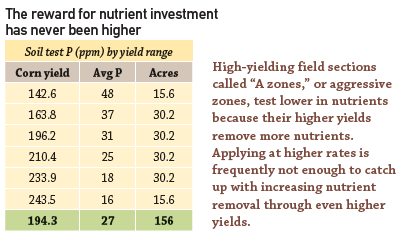When I began my career in crop production, we would routinely pull 20 soil sample cores, mix the cores in a bucket, pour one pound into a sample bag, send it off to the lab, get the results back and then pretend that what was on the sheet of paper accurately represented the nutrient levels for the entire field. While that may have been the best we could do then, we can do much better now – but many are treating entire fields the same. The economics of grid or small-zone sampling fields and variable-rate applying lime, phosphorus and potassium need to be revisited by many growers and their advisers. Nutrient prices have tripled since grid sampling was first introduced, and grain prices have escalated from the $2.50 per bushel days – meaning the reward for managing your nutrient investment intensely has never been higher.
In the early days of grid sampling, too many preached we would even out nutrient level within fields by applying phosphorus and potassium on the low-testing areas while mining down the high-testing areas. The pitch was that in a few years, the map that previously showed so much variation would be one color, with each part of the field in the same nutrient range. However, 15 years and seven to 10 variable-rate applications later, very few fields have uniform nutrient levels. Trying to create uniform fields was the wrong goal – the goal needed to be higher yields, not PPMs on a map. Grid sampling and variable rate nutrient applications are needed foundations for getting started in precision agronomy.

In many fields, a comparison of yield and fertility data will show the lower testing parts of the field are the highest yielding. These high-yielding parts of the field are what we divine as “A” zones, A standing for aggressive. A zones can test lower in nutrients because consistently higher yields remove more nutrients. Even though variable-rate applications might put more nutrients on these A zones, it is frequently not enough to catch up with increasing nutrient removal through even higher yields.
Think of A zones within your fields as Olympic swimmers – able to consume 8,000 calories per day and remain lean and fit. A zones are so productive, they warrant an all-you-can-eat buffet.
Just as more A zones call for being even more aggressive, for us, C zones are the parts of the field that justify being more conservative. In fields that have had straight-rate blends applied for years, it is easy to pick out C zones in the data. These consistently lower-yielding areas can become nutrient obese form lack of productivity. For Premier Crop, variable-rate applying nutrients is not about saving money; it is about reapportioning a higher nutrient investment within each field to maximize nutrient efficiency. One rate does not fit all.
Got data?
1. What changes have you implemented with your nutrient application investment since the prices of nutrients, corn and soybeans have escalated over the past several years
2. Do you see your yields "leveling off"? In what areas of your field could you push more? Sit down with your agronomic advisor to discuss ways you can get a yield bump for your A zones.
3. How do you proportion your nutrient investment from field to field, and acre to acre?



